Characteristics of a Spray-Dried Porcine Blood Meal for Aedes aegypti Mosquitoes
Abstract
Simple Summary
Abstract
1. Introduction
2. Materials and Methods
2.1. AM Formulation and Preparation
2.2. General Feeding Bioassay
2.3. Experimental Design
2.4. Phagostimulant Identification
2.4.1. SEM/Light Microscopy and Laser Diffraction
2.4.2. LC–MS/MS Proteomics
2.4.3. ATP Assays and Microbial Contamination
2.4.4. Heat Sterilization
2.4.5. Ball Milling
2.5. Meal Analyses
2.5.1. Engorgement
2.5.2. Fecundity
2.5.3. Colony Selection and Egg Viability
2.5.4. Meal Stability
2.5.5. Meal Cost
2.6. Statistical Analyses
3. Results
3.1. Phagostimulant Analyses
3.1.1. SEM/Light Microscopy and Laser Diffraction
3.1.2. LC–MS/MS Proteomics
3.1.3. ATP Assays and Microbial Contamination
3.1.4. Heat Sterilization
3.1.5. Ball Milling
3.2. Meal Analyses
3.2.1. Engorgement
3.2.2. Fecundity
3.2.3. Colony Selection and Egg Viability
3.2.4. Meal Stability
3.2.5. Cost Evaluation
4. Discussion
4.1. Phagostimulant Function and Nutrition
4.2. Improving SDPB Attributes
4.3. AM Performance
4.4. AM Cost and Stability
5. Conclusions
Supplementary Materials
Author Contributions
Funding
Data Availability Statement
Acknowledgments
Conflicts of Interest
References
- World Health Organization (WHO). Vector-Borne Diseases: Key Facts. Available online: https://www.who.int/news-room/fact-sheets/detail/vector-borne-diseases (accessed on 12 January 2024).
- Imam, H.; Sofi, G.; Zarnigar; Aziz, S. The Basic Rules and Methods of Mosquito Rearing (Aedes aegypti). Trop. Parasitol. 2014, 4, 53. [Google Scholar] [CrossRef] [PubMed]
- Styer, L.M.; Kent, K.A.; Albright, R.G.; Bennett, C.J.; Kramer, L.D.; Bernard, K.A. Mosquitoes Inoculate High Doses of West Nile Virus as They Probe and Feed on Live Hosts. PLoS Pathog. 2007, 3, e132. [Google Scholar] [CrossRef] [PubMed]
- Luo, Y.-P. A Novel Multiple Membrane Blood-Feeding System for Investigating and Maintaining Aedes aegypti and Aedes albopictus Mosquitoes. J. Vector Ecol. 2014, 39, 271–277. [Google Scholar] [CrossRef] [PubMed]
- Finlayson, C.; Saingamsook, J.; Somboon, P. A Simple and Affordable Membrane-Feeding Method for Aedes aegpyti and Anopheles minimus (Diptera: Culicidae). Acta Trop. 2015, 152, 245–251. [Google Scholar] [CrossRef]
- Siria, D.J.; Batista, E.P.A.; Opiyo, M.A.; Melo, E.F.; Sumaye, R.D.; Ngowo, H.S.; Eiras, A.E.; Okumu, F.O. Evaluation of a Simple Polytetrafluoroethylene (PTFE)-Based Membrane for Blood-Feeding of Malaria and Dengue Fever Vectors in the Laboratory. Parasit. Vectors 2018, 11, 236. [Google Scholar] [CrossRef]
- Pothikasikorn, J.; Boonplueang, R.; Suebsaeng, C.; Khaengraeng, R.; Chareonviriyaphap, T. Feeding Response of Aedes aegypti and Anopheles dirus (Diptera: Culicidae) Using out-of-Date Human Blood in a Membrane Feeding Apparatus. J. Vector Ecol. 2010, 35, 149–155. [Google Scholar] [CrossRef]
- Gonzales, K.; Hansen, I. Artificial Diets for Mosquitoes. Int. J. Environ. Res. Public Health 2016, 13, 1267. [Google Scholar] [CrossRef]
- Kandel, Y.; Mitra, S.; Jimenez, X.; Rodriguez, S.D.; Romero, A.; Blakely, B.N.; Cho, S.-Y.; Pelzman, C.; Hansen, I.A. Long-Term Mosquito Culture with SkitoSnack, an Artificial Blood Meal Replacement. PLoS Negl. Trop. Dis. 2020, 14, e0008591. [Google Scholar] [CrossRef]
- Dutra, H.L.C.; Rodrigues, S.L.; Mansur, S.B.; De Oliveira, S.P.; Caragata, E.P.; Moreira, L.A. Development and Physiological Effects of an Artificial Diet for Wolbachia-Infected Aedes aegypti. Sci. Rep. 2017, 7, 15687. [Google Scholar] [CrossRef]
- Tyler-Julian, K.; Darrisaw, C.; Lloyd, A.; Hoel, D. The Use of Frozen, Food-Grade Blood to Successfully Maintain Colonies of Four Species of Mosquitoes (Diptera: Culicidae). J. Insect Sci. 2021, 21, 1. [Google Scholar] [CrossRef]
- Gonzales, K.K.; Rodriguez, S.D.; Chung, H.-N.; Kowalski, M.; Vulcan, J.; Moore, E.L.; Li, Y.; Willette, S.M.; Kandel, Y.; Van Voorhies, W.A.; et al. The Effect of SkitoSnack, an Artificial Blood Meal Replacement, on Aedes aegypti Life History Traits and Gut Microbiota. Sci. Rep. 2018, 8, 11023. [Google Scholar] [CrossRef] [PubMed]
- Zhou, G.; Kohlhepp, P.; Geiser, D.; Frasquillo, M.D.C.; Vazquez-Moreno, L.; Winzerling, J.J. Fate of Blood Meal Iron in Mosquitoes. J. Insect Physiol. 2007, 53, 1169–1178. [Google Scholar] [CrossRef]
- Lukenge, M.; Ignell, R.; Hill, S.R. Chapter 17: Phagostimulants Drive the Acceptance of a Blood Meal in Disease Vectors. In Sensory Ecology of Disease Vectors; Ignell, R., Lazzari, C.R., Lorenzo, M.G., Hill, S.R., Eds.; Brill|Wageningen Academic: Wageningen, The Netherlands, 2022; pp. 469–488. ISBN 978-90-8686-380-8. [Google Scholar]
- Santos, D.; Maurício, A.C.; Sencadas, V.; Santos, J.D.; Fernandes, M.H.; Gomes, P.S. Spray Drying: An Overview. In Biomaterials—Physics and Chemistry—New Edition; Pignatello, R., Musumeci, T., Eds.; InTech: London, UK, 2018; ISBN 978-1-78923-064-2. [Google Scholar]
- Boel, E.; Koekoekx, R.; Dedroog, S.; Babkin, I.; Vetrano, M.R.; Clasen, C.; Van Den Mooter, G. Unraveling Particle Formation: From Single Droplet Drying to Spray Drying and Electrospraying. Pharmaceutics 2020, 12, 625. [Google Scholar] [CrossRef] [PubMed]
- Fischer, T.H.; DaCorta, J.A.; Galiger, M.L. Spray-Dried Blood Products and Methods of Making Same. U.S. Patent 9867782B2, 29 September 2022. [Google Scholar]
- Lee, G. Spray-Drying of Proteins. In Rational Design of Stable Protein Formulations; Carpenter, J.F., Manning, M.C., Eds.; Pharmaceutical Biotechnology; Springer: Boston, MA, USA, 2002; Volume 13, pp. 135–158. ISBN 978-1-4613-5131-3. [Google Scholar]
- Pinto, J.T.; Faulhammer, E.; Dieplinger, J.; Dekner, M.; Makert, C.; Nieder, M.; Paudel, A. Progress in Spray-Drying of Protein Pharmaceuticals: Literature Analysis of Trends in Formulation and Process Attributes. Dry. Technol. 2021, 39, 1415–1446. [Google Scholar] [CrossRef]
- Bhomia, R.; Trivedi, V.; Coleman, N.J.; Mitchell, J.C. The Thermal and Storage Stability of Bovine Haemoglobin by Ultraviolet–Visible and Circular Dichroism Spectroscopies. J. Pharm. Anal. 2016, 6, 242–248. [Google Scholar] [CrossRef]
- Drvenica, I.; Stancic, A.; Kalusevic, A.; Markovic, S.; Dragisic-Maksimovic, J.; Nedovic, V.; Bugarski, B.; Ilic, V. Maltose-Mediated Long-Term Stabilization of Freeze- and Spray- Dried Forms of Bovine and Porcine Hemoglobin. J. Serbian Chem. Soc. 2019, 84, 1105–1117. [Google Scholar] [CrossRef]
- Both, E.M.; Boom, R.M.; Schutyser, M.A.I. Particle Morphology and Powder Properties during Spray Drying of Maltodextrin and Whey Protein Mixtures. Powder Technol. 2020, 363, 519–524. [Google Scholar] [CrossRef]
- Tao, Y.; Chen, Y.; Howard, W.; Ibrahim, M.; Patel, S.M.; McMahon, W.P.; Kim, Y.J.; Delmar, J.A.; Davis, D. Mechanism of Insoluble Aggregate Formation in a Reconstituted Solution of Spray-Dried Protein Powder. Pharm. Res. 2023, 40, 2355–2370. [Google Scholar] [CrossRef]
- Kumar, R.; Thakur, A.K.; Chaudhari, P.; Banerjee, N. Particle Size Reduction Techniques of Pharmaceutical Compounds for the Enhancement of Their Dissolution Rate and Bioavailability. J. Pharm. Innov. 2022, 17, 333–352. [Google Scholar] [CrossRef]
- Tunick, M.H. Whey Protein Production and Utilization: A Brief History. In Whey Processing, Functionality and Health Benefits; Onwulata, C.I., Huth, P.J., Eds.; Wiley: Hoboken, NJ, USA, 2008; pp. 1–13. ISBN 978-0-8138-0903-8. [Google Scholar]
- Adler, M.; Unger, M.; Lee, G. Surface Composition of Spray-Dried Particles of Bovine Serum Albumin/Trehalose/Surfactant. Pharm. Res. 2000, 17, 863–870. [Google Scholar] [CrossRef]
- Millqvist-Fureby, A.; Malmsten, M.; Bergenståhl, B. Spray-Drying of Trypsin—Surface Characterisation and Activity Preservation. Int. J. Pharm. 1999, 188, 243–253. [Google Scholar] [CrossRef] [PubMed]
- Masters, S.W.; Knapek, K.J.; Kendall, L.V. Rearing Aedes Aegypti Mosquitoes in a Laboratory Setting. Lab. Anim. Sci. Prof. 2020, 55, 42–45. [Google Scholar]
- Pavani, P.; Kumar, K.; Rani, A.; Venkatesu, P.; Lee, M.-J. The Influence of Sodium Phosphate Buffer on the Stability of Various Proteins: Insights into Protein-Buffer Interactions. J. Mol. Liq. 2021, 331, 115753. [Google Scholar] [CrossRef]
- Leoci, R. Animal By-Products (ABPs): Origins, Uses, and European Regulations; Universitas Studiorum: Mantua, Italy, 2014. [Google Scholar]
- AquaSnap Total ATP Tests: Product Guide; Hygiena: Camarillo, CA, USA, 2016.
- SystemSURE Plus and EnSure(TM) Operator Manual, V5.0; Hygiena: Camarillo, CA, USA, 2020.
- Keigwin, R.; Harrigan-Farrelly, J.; Rossi, L.; Honsenger, J. Accelerated Storage Stability and Corrosion Characteristics Study Protocol; U.S. Environmental Protection Agency: Washington, DC, USA, 2012.
- Sithole, R.; McDaniel, M.R.; Goddik, L.M. Rate of Maillard Browning in Sweet Whey Powder. J. Dairy Sci. 2005, 88, 1636–1645. [Google Scholar] [CrossRef] [PubMed]
- HemoStat Laboratories. Defibrinated Blood: Bovine/Horse/Porcine/Rabbit/Sheep. Available online: https://hemostat.com/defibrinated-blood/ (accessed on 13 January 2024).
- Dixon, A.R.; Vondra, I. Biting Innovations of Mosquito-Based Biomaterials and Medical Devices. Materials 2022, 15, 4587. [Google Scholar] [CrossRef]
- Erickson, H.P. Size and Shape of Protein Molecules at the Nanometer Level Determined by Sedimentation, Gel Filtration, and Electron Microscopy. Biol. Proced. Online 2009, 11, 32–51. [Google Scholar] [CrossRef]
- Brutin, D.; Sobac, B.; Loquet, B.; Sampol, J. Pattern Formation in Drying Drops of Blood. J. Fluid Mech. 2011, 667, 85–95. [Google Scholar] [CrossRef]
- Steinbrunner, P.; Marks, B.P.; Ryser, E.T.; Suehr, Q.J.; Jeong, S. Fate of Salmonella and Enterococcus Faecium during Pilot-Scale Spray Drying of Soy Protein Isolate. J. Food Prot. 2021, 84, 674–679. [Google Scholar] [CrossRef]
- Ling Chang, C. Evaluation of Yeasts and Yeast Products in Larval and Adult Diets for the Oriental Fruit Fly, Bactrocera Dorsalis, and Adult Diets for the Medfly, Ceratitis capitata, and the Melon Fly, Bactrocera curcurbitae. J. Insect Sci. 2009, 9, 23. [Google Scholar] [CrossRef]
- Chia, S.Y.; Tanga, C.M.; Osuga, I.M.; Cheseto, X.; Ekesi, S.; Dicke, M.; Van Loon, J.J.A. Nutritional Composition of Black Soldier Fly Larvae Feeding on Agro-industrial By-products. Entomol. Exp. Appl. 2020, 168, 472–481. [Google Scholar] [CrossRef]
- Cresoni-Pereira, C.; Zucoloto, F.S. Influence of Quantities of Brewer Yeast on the Performance of Anastrepha Obliqua Wild Females (Diptera, Tephritidae). Iheringia Sér. Zool. 2001, 91, 53–60. [Google Scholar] [CrossRef]
- Ross, P.A.; Lau, M.-J.; Hoffmann, A.A. Does Membrane Feeding Compromise the Quality of Aedes aegypti Mosquitoes? PLoS ONE 2019, 14, e0224268. [Google Scholar] [CrossRef] [PubMed]
- Arévalo-Cortés, A.; Granada, Y.; Torres, D.; Triana-Chavez, O. Differential Hatching, Development, Oviposition, and Longevity Patterns among Colombian Aedes aegypti Populations. Insects 2022, 13, 536. [Google Scholar] [CrossRef]
- Phasomkusolsil, S.; Tawong, J.; Monkanna, N.; Pantuwatana, K.; Damdangdee, N.; Khongtak, W.; Kertmanee, Y.; Evans, B.P.; Schuster, A.L. Maintenance of Mosquito Vectors: Effects of Blood Source on Feeding, Survival, Fecundity, and Egg Hatching Rates. J. Vector Ecol. 2013, 38, 38–45. [Google Scholar] [CrossRef] [PubMed]
- Pascoe, L.; Clemen, T.; Bradshaw, K.; Nyambo, D. Review of Importance of Weather and Environmental Variables in Agent-Based Arbovirus Models. Int. J. Environ. Res. Public Health 2022, 19, 15578. [Google Scholar] [CrossRef] [PubMed]
- Carvalho, D.O.; Nimmo, D.; Naish, N.; McKemey, A.R.; Gray, P.; Wilke, A.B.B.; Marrelli, M.T.; Virginio, J.F.; Alphey, L.; Capurro, M.L. Mass Production of Genetically Modified Aedes aegypti for Field Releases in Brazil. J. Vis. Exp. 2014, 83, 3579. [Google Scholar] [CrossRef]
- Zheng, M.-L.; Zhang, D.-J.; Damiens, D.D.; Lees, R.S.; Gilles, J.R.L. Standard Operating Procedures for Standardized Mass Rearing of the Dengue and Chikungunya Vectors Aedes aegypti and Aedes albopictus (Diptera: Culicidae)—II—Egg Storage and Hatching. Parasit. Vectors 2015, 8, 348. [Google Scholar] [CrossRef]



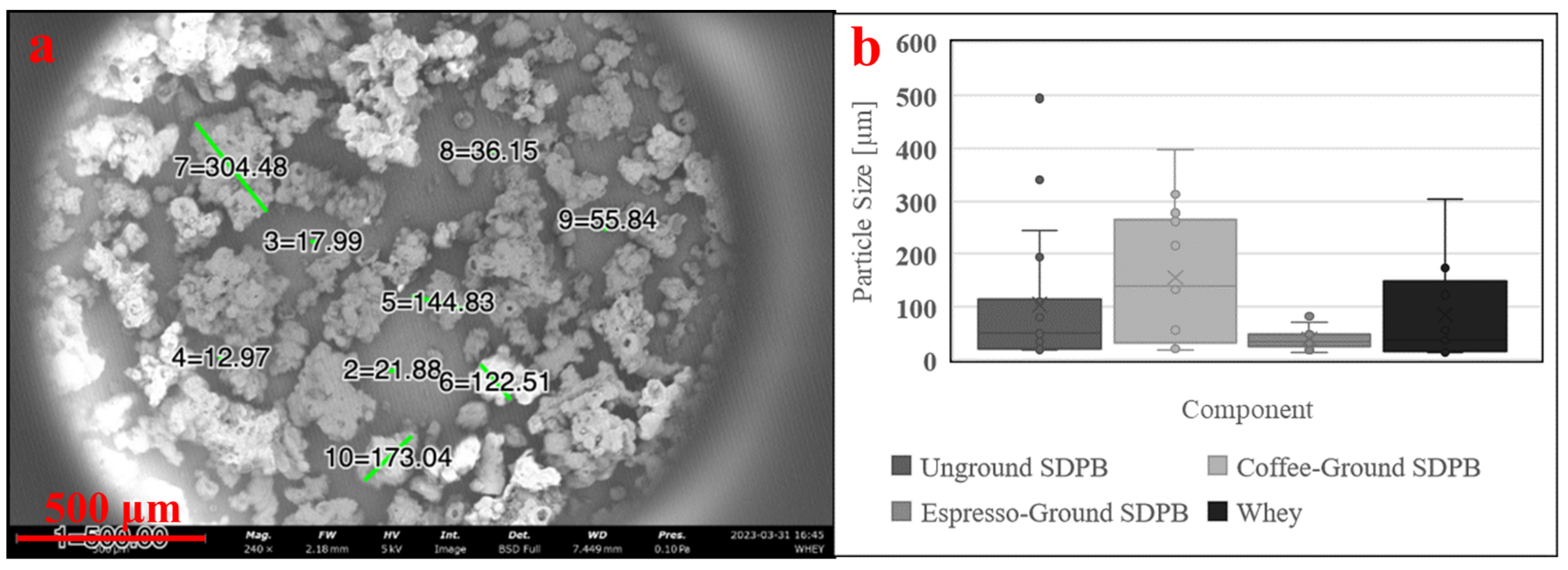
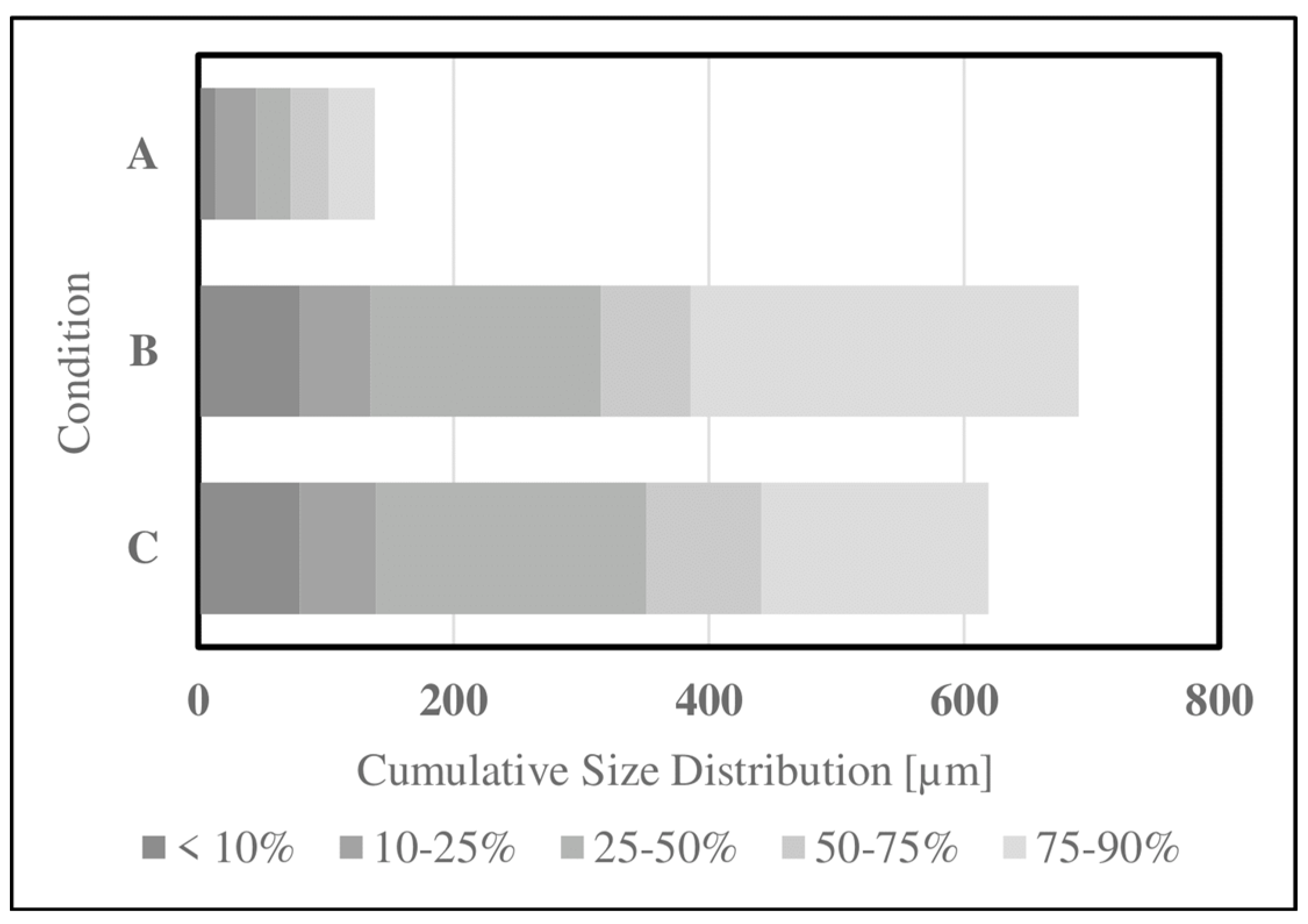

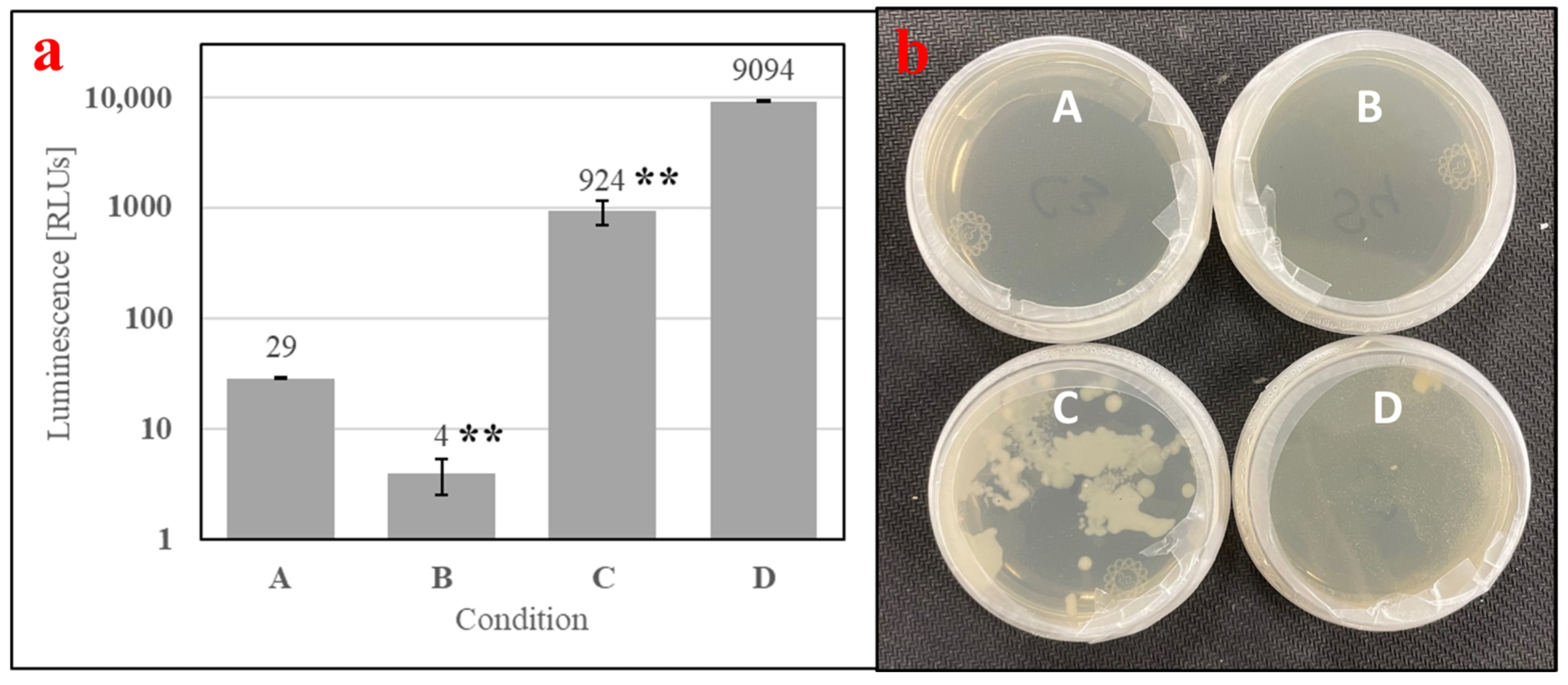

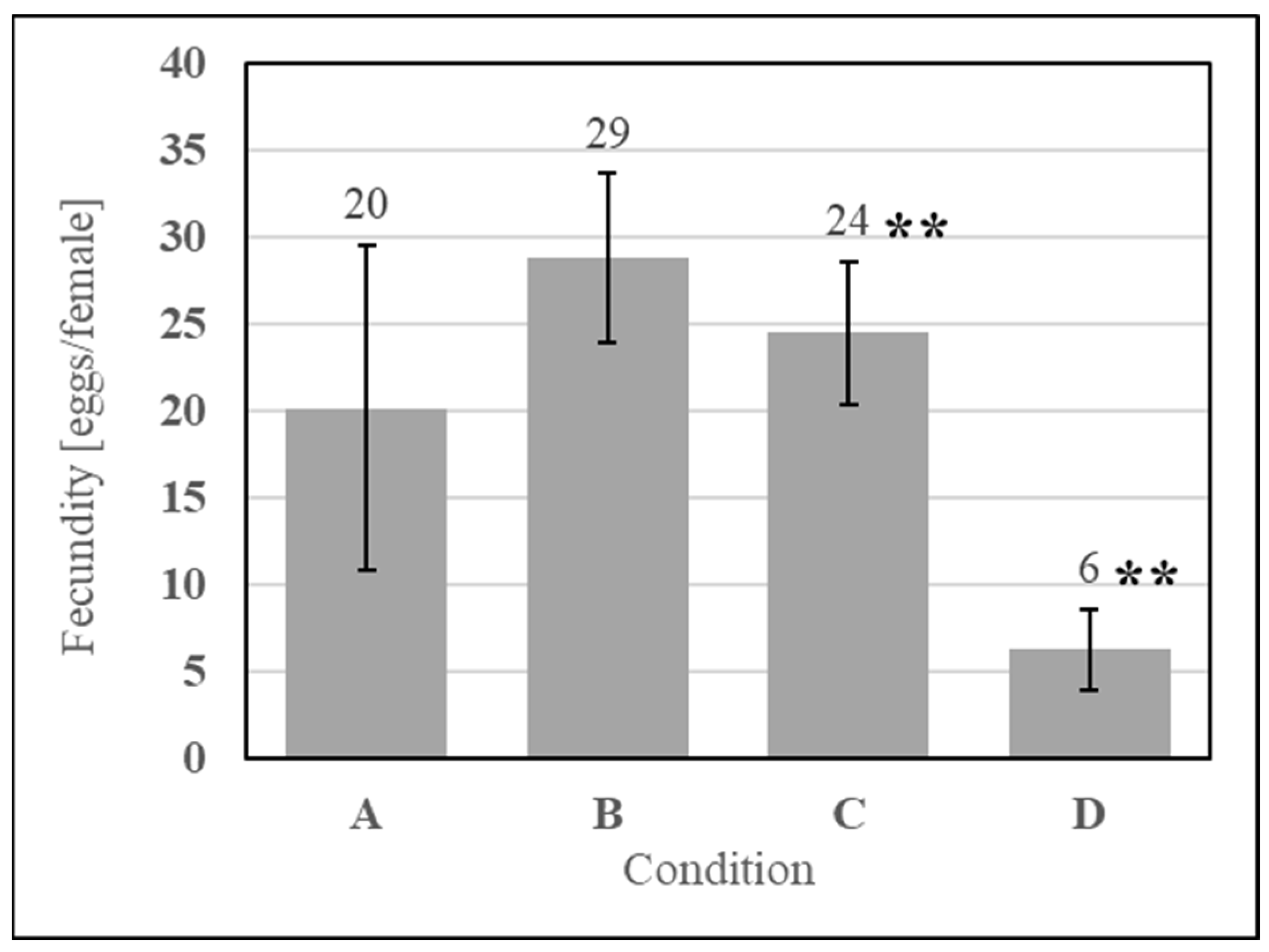



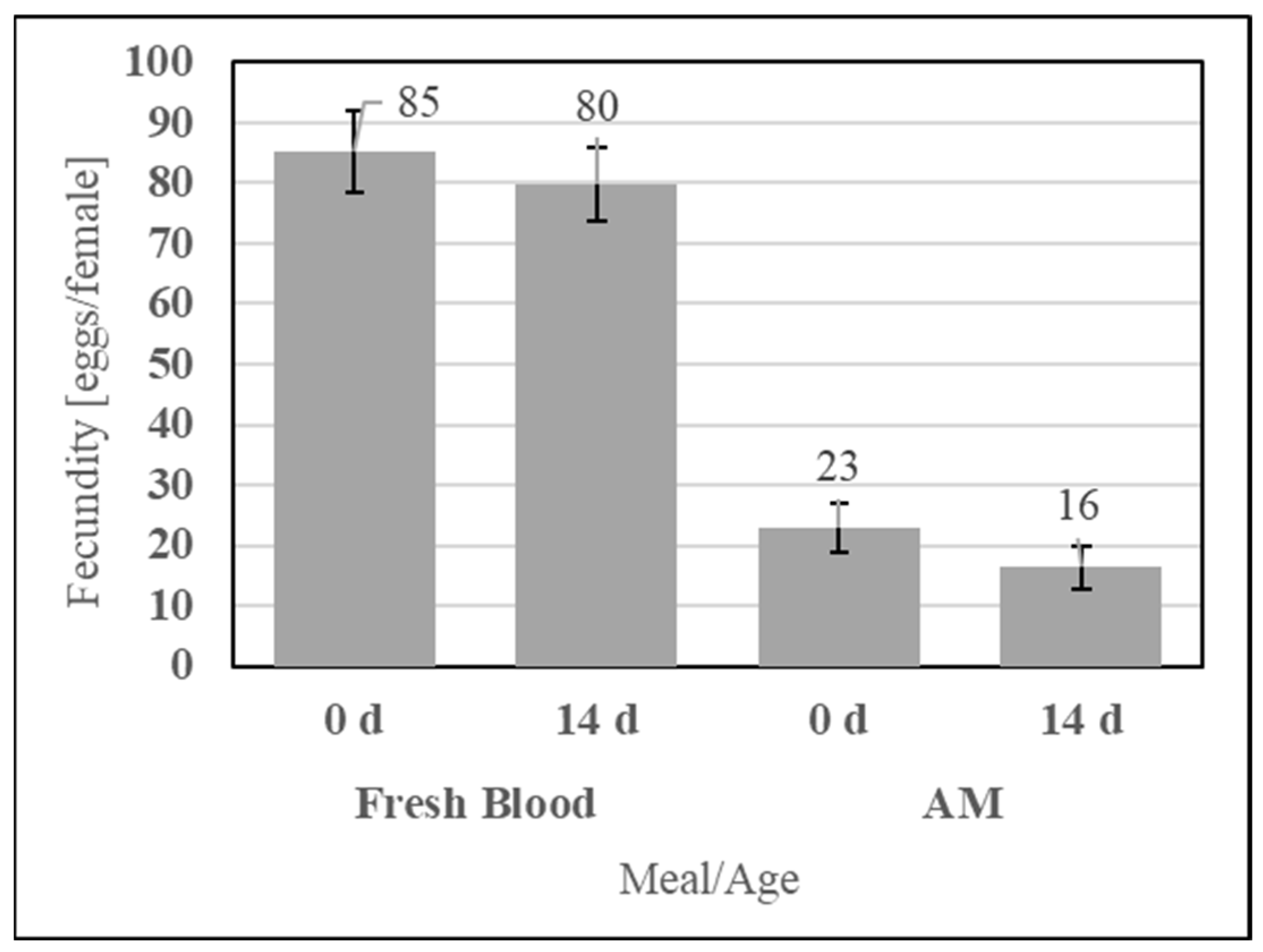
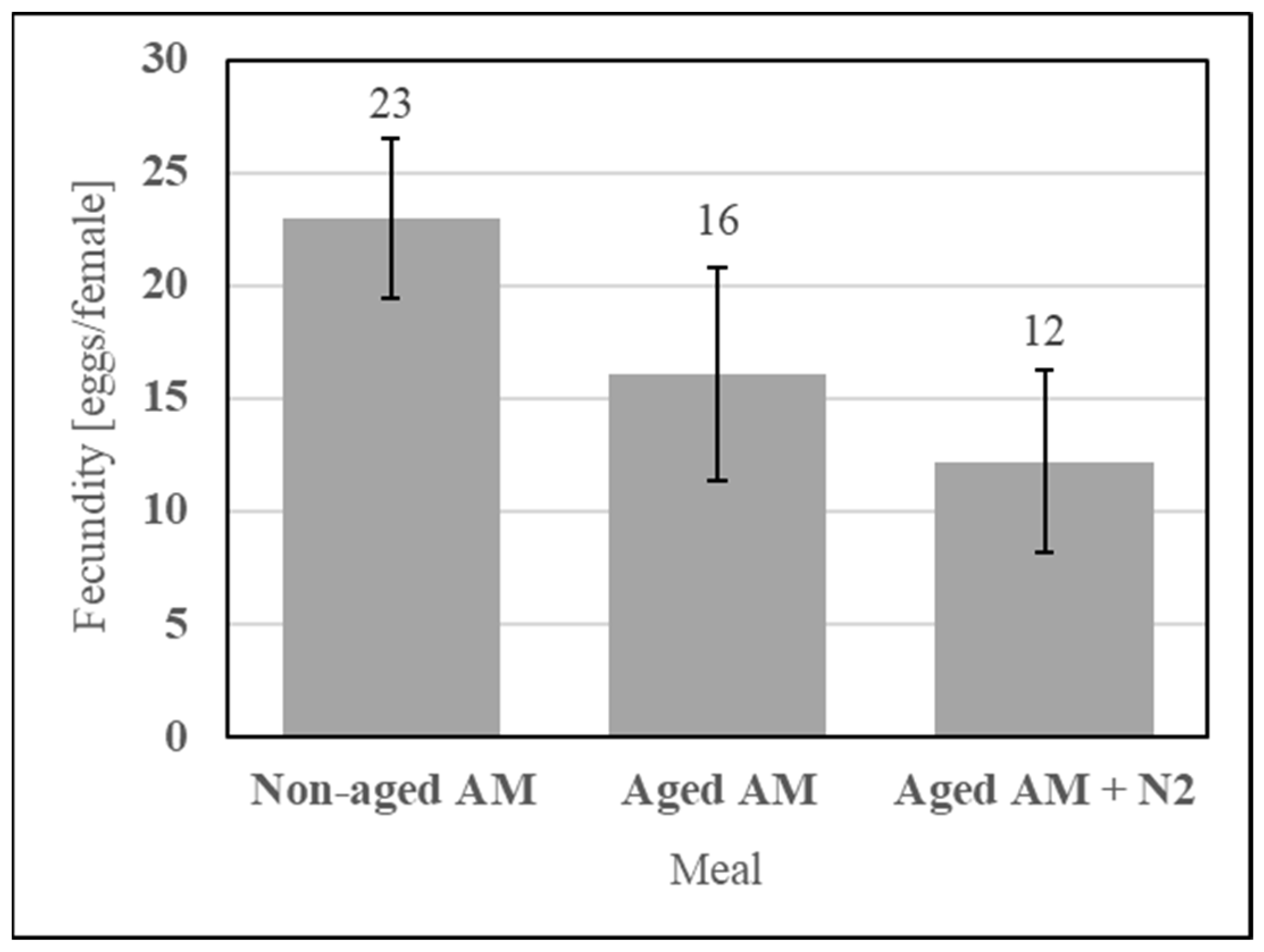
| Component | Manufacturer | Concentration | Preparation |
|---|---|---|---|
| 10× phosphate-buffered saline | Thermo Scientific Inc. (Waltham, MA, USA) | Diluted in 9 parts DI water, 1 part 10× PBS | Prepared first. |
| Spray-dried porcine blood (SDPB) | Earthworks Health LLC (Norfolk, NE, USA); Tyson Ingredient Solutions (Tyson Foods, Inc.; Springdale, AR, USA) | 20% (w/v) in 1× PBS | Coffee-ground. Added after PBS is diluted. |
| Whey protein powder, unflavored | Jarrow Formulas (Sherman Oaks, CA, USA) | 10% (w/v) in 1× PBS | Added after SDPB. |
| Unground SDPB | Coffee-Ground SDPB | Ball-Milled SDPB | Whey | |||||
|---|---|---|---|---|---|---|---|---|
| Rank | Protein | Score | Protein | Score | Protein | Score | Protein | Score |
| 1 | Protease 1 OS = A. lyticus | 321.35 | Protease 1 OS = A. lyticus | 401.92 | Hemoglobin subunit alpha OS = B. taurus | 246.04 | Beta-lactoglobulin OS = B. taurus | 3118.98 |
| 2 | Hemoglobin subunit alpha OS = B. taurus | 203.16 | Ubiquitin C OS = S. scrofa | 73.73 | Hemoglobin subunit beta OS = B. taurus | 158.81 | Albumin OS = B. taurus | 271.43 |
| 3 | Hemoglobin fetal subunit beta OS = B. taurus | 99.95 | Hemoglobin subunit alpha OS = B. taurus | 68.57 | Protease 1 OS = A. lyticus | 82.95 | Alpha-lactalbumin OS = B. taurus | 136.63 |
| 4 | Hemoglobin subunit beta OS = B. taurus | 99.7 | Beta-lactoglobulin OS = B. taurus | 61 | Ubiquitin C OS = S. scrofa | 33.37 | Uncharacterized protein OS = B. taurus | 55.11 |
| 5 | Albumin (Fragment) OS = S. scrofa | 68.44 | Albumin (Fragment) OS = S. scrofa | 49.29 | Albumin (Fragment) OS = S. scrofa | 22.92 | Complement C3 OS = B. taurus | 42.54 |
| 6 | Apolipoprotein A-I OS = B. taurus | 44.51 | Alpha-lactalbumin OS = B. taurus | 46.81 | Apolipoprotein A-I OS = B. taurus | 21.8 | Vitamin D-binding protein OS = B. taurus | 29.39 |
| 7 | Ubiquitin C OS = S. scrofa | 35.63 | Hemoglobin fetal subunit beta OS = B. taurus | 45.72 | Filamin A, alpha OS = S. scrofa | 20.91 | Transthyretin OS = B. taurus | 24.91 |
| 8 | Tropomyosin 3 OS = S. scrofa | 35.2 | Apolipoprotein A-I OS = B. taurus | 44.3 | Actin, gamma 1 OS = S. scrofa | 13.66 | Zinc-alpha-2-glycoprotein OS = B. taurus | 20.59 |
| 9 | Beta-lactoglobulin OS = B. taurus | 20.97 | Hemoglobin subunit beta OS = B. taurus | 42.45 | Alpha-1-antiproteinase OS = B. taurus | 18.05 | ||
| 10 | Tropomyosin beta chain OS = B. taurus | 19.63 | Tropomyosin 3 OS = S. scrofa | 41.71 | Serotransferrin OS = B. taurus | 17.77 | ||
| 11 | Alpha1 chain of type I collagen OS = S. scrofa | 17.3 | Albumin OS = B. taurus | 34.02 | Protease 1 OS = A. lyticus | 13.19 | ||
| 12 | Actin, gamma 1 OS = S. scrofa | 14.36 | Trypsin OS = S. scrofa | 20.4 | ||||
| 13 | Carbamoyl-phosphate synthetase 1 (Fragment) OS = S. scrofa | 14.11 | Tropomyosin beta chain OS = B. taurus | 16.57 | ||||
| 14 | Actin, gamma 1 OS = S. scrofa | 10.99 | ||||||
| 15 | Carbamoyl-phosphate synthetase 1 (Fragment) OS = S. scrofa | 10.64 | ||||||
| Condition | Meal Mass (Mean ± SE) | ANOVA | Tukey HSD p | |||
|---|---|---|---|---|---|---|
| df, F, p | Fresh Blood | SDPB + Whey (AM) | SDPB | Whey | ||
| Fresh Blood | 1.74 ± 0.16 | 3 10.58 **** | 0 | 1 | 0.073 | *** |
| SDPB + Whey (AM) | 1.75 ± 0.29 | 0 | 0.071 | *** | ||
| SDPB | 0.90 ± 0.27 | 0 | 0.13 | |||
| Whey | 0.15 ± 0.14 | 0 | ||||
| Diet | Component | Price/Unit | Cost |
|---|---|---|---|
| Simple AM | Spray-dried porcine blood | USD 2.64/kg | USD 0.53 |
| Whey protein powder | USD 39.60/kg | USD 3.60 | |
| Thermo-Fischer 10X PBS | USD 53.00/L | USD 5.30 | |
| Total per liter | USD 9.79 | ||
| SkitoSnack | Bovine serum albumin | USD 0.89/g | USD 178.40 |
| Bovine hemoglobin | USD 0.53/g | USD 2.63 | |
| Chicken yolk | USD 0.48/g | USD 2.39 | |
| Adenosine triphosphate | USD 19.04/g | USD 31.48 | |
| Sodium chloride | USD 0.04/g | USD 0.36 | |
| Sodium bicarbonate | USD 0.11/g | USD 0.21 | |
| Potassium chloride | USD 0.162/g | USD 0.05 | |
| Calcium chloride | USD 0.104/g | USD 0.03 | |
| Magnesium chloride | USD 0.053/g | USD 0.01 | |
| Total per liter | USD 215.54 | ||
| Fresh Bovine Blood | Total per liter | USD ~82 |
Disclaimer/Publisher’s Note: The statements, opinions and data contained in all publications are solely those of the individual author(s) and contributor(s) and not of MDPI and/or the editor(s). MDPI and/or the editor(s) disclaim responsibility for any injury to people or property resulting from any ideas, methods, instructions or products referred to in the content. |
© 2024 by the authors. Licensee MDPI, Basel, Switzerland. This article is an open access article distributed under the terms and conditions of the Creative Commons Attribution (CC BY) license (https://creativecommons.org/licenses/by/4.0/).
Share and Cite
Weaver, A.R.; Rajagopal, N.R.; Pereira, R.M.; Koehler, P.G.; MacIntosh, A.J.; Baldwin, R.W.; Batich, C.D. Characteristics of a Spray-Dried Porcine Blood Meal for Aedes aegypti Mosquitoes. Insects 2024, 15, 716. https://doi.org/10.3390/insects15090716
Weaver AR, Rajagopal NR, Pereira RM, Koehler PG, MacIntosh AJ, Baldwin RW, Batich CD. Characteristics of a Spray-Dried Porcine Blood Meal for Aedes aegypti Mosquitoes. Insects. 2024; 15(9):716. https://doi.org/10.3390/insects15090716
Chicago/Turabian StyleWeaver, Alexander R., Nagarajan R. Rajagopal, Roberto M. Pereira, Philip G. Koehler, Andrew J. MacIntosh, Rebecca W. Baldwin, and Christopher D. Batich. 2024. "Characteristics of a Spray-Dried Porcine Blood Meal for Aedes aegypti Mosquitoes" Insects 15, no. 9: 716. https://doi.org/10.3390/insects15090716
APA StyleWeaver, A. R., Rajagopal, N. R., Pereira, R. M., Koehler, P. G., MacIntosh, A. J., Baldwin, R. W., & Batich, C. D. (2024). Characteristics of a Spray-Dried Porcine Blood Meal for Aedes aegypti Mosquitoes. Insects, 15(9), 716. https://doi.org/10.3390/insects15090716






